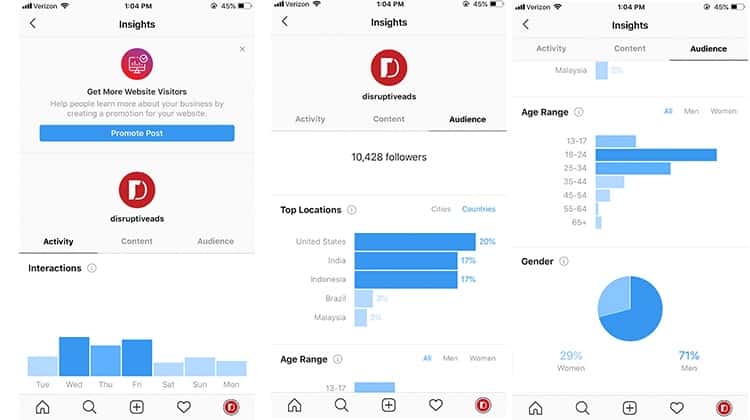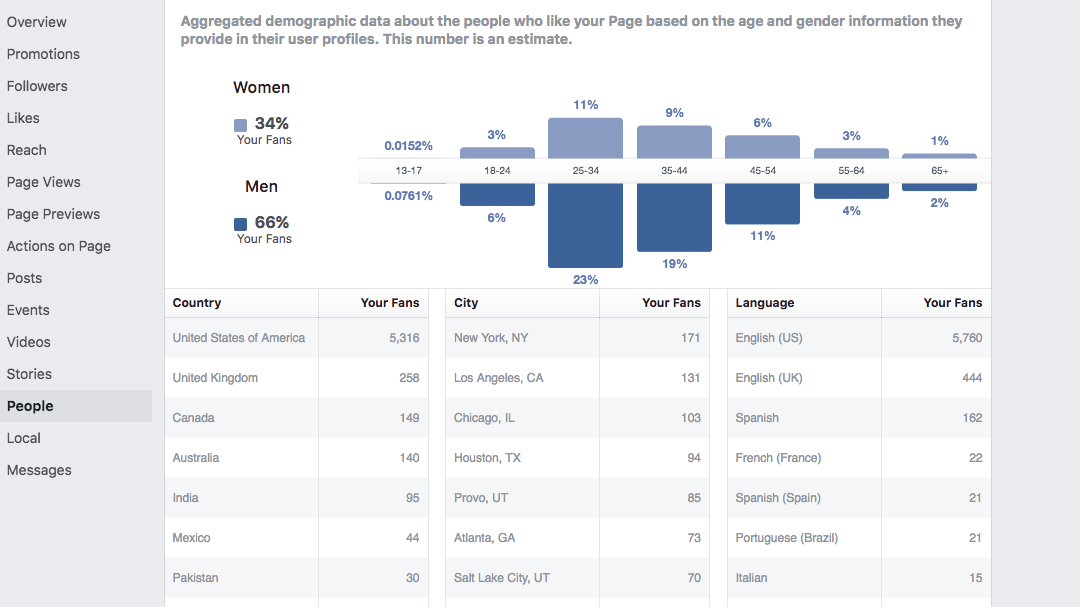Beware of Vanity: Tracking Social Media Metrics Effectively
by Cydney Hatch • February 11, 2019
You know the feeling—the rush if you will—when you watch your social media numbers spike after publishing something and you just can’t stop checking to see how many new social hearts are flooding your inbox.
I mean, this is the social dopamine rush every marketer lives for, right?
Now, while we should always celebrate when people follow and like us, they aren’t the ultimate measure of social media success. You need to beware of vanity metrics and focus on what truly matters when tracking social media progress.
In today’s world where many people can buy vanity followers, engagements and likes for their social media content, you need to ask yourself:
What metrics and stats should I actually be tracking?
Although there is room for vanity metrics to be used the right way, in this article we will talk about everything you need to know about effective social media metric tracking and which ones really matter to the bottom line of your business.
Vanity vs Meaningful Metrics
Worried that you don’t have as many Instagram followers as your competition? Don’t be!
The crazy thing about vanity metrics is you can become Internet famous for $68 without ever existing on the social media platform before!

When it comes to social media metrics and campaign tracking, one of the easiest mistakes you can make is to focus on “vanity metrics” such as page/video views, number of followers, number of likes or the number of downloads.
Although these numbers look good on paper and increase your legitimacy, they don’t always give you insight into how that content helped your business.
On the other hand, meaningful metrics are data points that tie to specific tasks you can improve towards business goals. To put it simply, these metrics tell you where the real opportunities are for growth are:
- Repeat Pageviews
- Visitor Recency
- Number of Blog/Article Comments
- Content Shares
- Conversion Rates
Social metrics turn into “vanity” metrics when you use them to toot your business horn instead of connecting social media back to real business objectives!
So, don’t get caught up playing the endless game of tracking vanity metrics over tracking measurable ones that will long term benefit your business. To help you turn your social media mirror in the right direction, look to what matters not just “how you look online”. Let’s take a look at things you should consider.
Goals Before Metrics
Time is valuable, so if you’re spending a lot of time on social media for your business, wouldn’t you want to make sure you’re receiving the best results possible? (I think yes!).
This is where setting business goals in relation to social media platforms comes in handy!
Before you figure out which metrics you should be tracking, you need to determine what goals you have for your social media platforms and how they relate back to your business as a whole.
Tracking metrics that do not align with specific business goals can quickly burn money and precious time! What metrics you should be tracking in your business really depend on your goals, but here are examples of some social media goals:
- Increase Brand Awareness
- Build an Engaged Community
- Research and Develop Your Audience
- Drive Sales and Leads
- Increase Audience Engagement
- Drive Traffic to Websites/Specific Pages
- Generate New Leads
- Increase Public Relations/Mentions
- Increase Industry Collaborations
- Improve ROI
If you know what some of your goals will be, a great technique to keep you on track is using the SMART method. SMART is an acronym for:
- (S) Specific: Your goals should be clear, simple and defined
- (M) Measurable: This is where analytics come in. You want a goal that has one or more metrics you can measure.
- (A) Achievable: Is it achievable or impossible given your resources?
- (R) Realistic: With your current resources of time and money, is it possible to achieve your goals?
- (T) Time: Every goal needs a time frame, whether it’s one year or several months
Once you determine your business social media goals, audit your profiles to create a baseline knowledge of where you are starting. This will help you plan how to be effective towards where you want to go and what growth you need to see to get there!
There are tons of analytic tracking systems like Google Analytics as well as internally built social trackers like Instagram Insights and Facebook Insights that can help you on this journey!
Meaningful Social Media Metrics
As much as I’d like to give you a fail-proof list of the specific data points you should be tracking, no one set of metrics work across the many different businesses out there. Every business is different, and every website asks different things of its visitors so you will need to identify metrics that best fit your business needs!
Once you have a solid plan in place on where you want your social media platforms to go, let’s take a look at measurable and strategically metrics you should consider tracking for your business social media needs:
Social Media Reach and Brand Awareness
Reach and Brand Awareness, top-funnel metrics, are a measure of how many people your brand and content are getting in front of during a set period of time. Of course, the more eyes, the merrier your numbers. So, while reach does not always paint the full picture of your social endeavors, it is a critical metric to monitor.
Strong reach is an indication of the impact your website and social media presence is having on your ability to attract potential customers! If you are able to build a recognizable, well-respected, and influential brand, your other goals will be a lot easier to accomplish as well!
(P.S. you will also see something called “impressions”…reach is the number of people who see a post, while Impressions are the number of times your content is displayed)
How to Measure:
You can track your reach in all your individual social media platforms.
To track this social media metric, look at your:
- Follower Growth
- Individual Post Reach
- Campaign Reach
- Audience Growth
For example, if you wanted to take a look at your reach numbers on Instagram, look to your Insights page within your business profile.
As shown below, you can access reach metrics as well as many others going to your settings tab and go to “Insights.”

From there go down to your “REACH” section and see your results! In this example, you see that between Jan-21st and Jan 27th we saw a +107 which is a decent amount of reach!
By tracking reach, you can help your business “reach” new heights and new audiences!
BONUS: Social Media Mentions
Social media mentions are a useful way to measure brand awareness and find out who’s really talking about you online. Closely tracking mentions shows you:
- How engaged users are with your content
- The best days and times to share on social
- Whether users like your product or service
This is also perfect for product launches to see if promotional efforts are paying off!
Social Media Engagement
Engagement is the social media metric that informs you how many people are interacting with your content on social media platforms. Engagement social media metrics are things like comments, shares, likes, clicks, and saves (all actionable items).
Honestly, this is one of the MOST IMPORTANT ITEMS TO MONITOR.
Your social media engagement rate will tell you how interested your audience is, plus what content resonates and what content does not, therefore, allowing you to tweak your social strategy based on this information!
How to Measure:
Each social media platform where you’re running ads or sharing content should show you the engagement rate of each individual ad/post. Run and test multiple content pieces so that you can determine a typical engagement rate for your account!
To dig deeper, you also might want to track and look at:
- Average Engagement: number of engagement actions (e.g., likes, shares, comments) a post receives relative to your total number of followers
- Applause Rate: the number of approval actions (e.g., likes, favorites) a post receives relative to your total number of followers
- Amplification Rate: the ratio of shares per post to the number of overall followers
- Virality Rate: the number of people who shared your post relative to the number of unique views (i.e., impressions) it had during a reporting period
For example, you can use these specific metrics to inform the different split tests you’ll want to run on various social media posts and post types.
Do videos do well on your Instagram account?
Do infographics work on Facebook?
Does your audience engage with polls and surveys on Twitter?
There’s only one way to find out: testing what your audiences want to see! When you find the types of posts that resonate best with your community, you can share more of those types over others in order to drive increased engagement!
Social Media Audience Growth/Rate of Followers
Social media audience growth is a social media metric that shows you the number of followers you have gained over a certain period of time.
It’s important to pay attention to the rate that you’re obtaining followers. If you see a slow and unreliable trickle of people following your accounts, you may want to increase your posting speed. If you’re losing followers, you should examine what has been shared or posted recently and question whether you need to adjust your strategy.
How to Measure:
Benchmark your audience on each social network and measure the increase in those numbers every day, week, month or for another specific time table to determine the speed at which you’re attaining new fans.
BONUS: Visits vs Unique Visitors
Visits are the number of each time a person visits your website while unique visitors are counting each person only once. So, getting a good number of unique visitors is important especially when you’re hell-bent on growing your business!
Social Media Audience Demographics
Social media demographics are the data points that share the qualities and characteristics your target audience share from points like income, age, gender, geographic location, and even their likes and interests!
The challenge of reaching new audiences has never been harder, but grasping up-to-date data on social media demographics helps. This information is crucial because it can help you paint a picture of your target market, understand what they are interested in, and—most importantly—what they want (which you’ll give them).
How to Measure/Track:
Most tracking systems within your social platforms or if you hire a tracking service have these data points regularly available to you. For example, on Instagram Insights and Facebook Insights you can see the following demographics for Disruptive:


Many times, they break down the location, age, and gender of your audience. With the paid options, you can look at more intimate data points from your followers.
Social Media Referrals
Referrals and the traffic they bring are a measure of how many visitors are coming to your website from social media accounts. When someone clicks a URL link in your bio or a link within a social media post and they end up on your website, that is a referral visit!
For many businesses, social media referrals are a significant source of traffic coming to a site! This is why sharing a clear call to actions and clear contact information is crucial to your social media pages and posts!
How to Measure:
You can track this metric through Google Analytics. Go to Acquisition > Social to see which networks are driving traffic to your site and how much.
As a best practice, you should be using UTM parameters on your social links so you can separate out organic referrals from paid referrals and clearly see which campaigns are driving the most traffic to your website!
Social Media Fan-Base
Social Media Fan-Base describes how many people are sharing your content and the quantity of “buzz” your business has online.
Common metrics of measuring a loyal fanbase on social media can include:
- Photos Tagged of Your Business
- Branded Hashtags Being Used
- Instagram and Facebook Stories That Hashtag You
- Number of Engagements
- Engagements Per Follower
How to Measure:
This will generally be a quantitative data point you will collect, but doing some social media listening will greatly benefit your business, too. Pay attention to what people are saying, how they are using your branded hashtag(s) and other viral/sharable posts.
Paid Social Media Metrics to Measure
In addition to the organic social media metrics we’ve just discussed, if you are running paid social media campaigns, you’ll also want to track the following metrics:
Social Media Bounce Rate
Bounce rate measures the number of people who landed on your website or landing page and then immediately peace out. This could be due to a variety of reasons, such as accidental clicks, but if the traffic coming to your site from social media has an unusually high bounce rate, it’s a sign that your site isn’t giving users what they hoped to find.
In other words: high bounce rate = bad.
Keep readers’ attention with a good call-to-action (CTA), as well as links to other content and other parts of your site. A declining bounce rate is a great metric to report because it suggests your blog is growing in its interest to your visitors.
How to Measure:
To measure your bounce rate, you can use tools like Google Analytics. Within Google Analytics, go to Acquisition > All Traffic, then segment by Channels. You’ll then find a column labeled “Bounce Rate.”
Click on the heading to sort your channels from lowest to highest bounce rate.
Paid Social Media ROI and Conversions
Conversions are quite specific to your specific business model and your paid social media tactics, so you will need to define what is relative to your strategy. Conversions can be:
- Website Purchases
- Subscriptions to Newsletters or services
- Registration to Events
- Sponsorships
- Donations
- etc…
Conversions are the business goals you’re ultimately trying to achieve, the goals that raise your bottom line and make you money. Whatever your specific conversions, your conversion rate is a measure of how many people who click your ad go on to complete the action you want them to take, resulting in monetary gain for your business.
How to Measure:
Typically, you will follow some type of process like the following:
STEP 1: Create a post with a call-to-action link. Use a URL shortener to make it trackable.
STEP 2: Place a “cookie” on the user’s machine. Doing so attaches the lead to a campaign.
STEP 3: Use the campaign reporting to track the total number of clicks and conversions generated by the post.
STEP 4: Divide conversions by total clicks and multiply by 100 to get your conversion rate percentage.
Seeing how many people are actually converting will be the lifeblood of your business success. If people aren’t taking action after seeing your ads or content, you will go nowhere!
BONUS: Cost per Conversion & Click Through Rate
Your cost per conversion, or cost per action, is the what it costs to secure a conversion once you figure in the costs of individual ad clicks, not all of which will lead to the conversions you want. For example, if you’re paying $0.10 for each ad click, but it takes 100 ad clicks to get a single conversion, your cost per conversion will be $10.
How To Measure:
You can measure this in your ad campaign builder, where they most likely will calculate your cost per conversion for you. Keep a very close eye on this metric so you know you’re getting ROI from your social media campaigns.
Click through rate is how often people click on the call-to-action link in your post.
Tracking CTR, often and accurately, will give you invaluable insight into how compelling your offer is to the target audience.
Tools to Help You Measure Social Media Metrics
If you are wondering how you can track a lot of these social media metrics, below is a list of dynamic tools you can easily start today to better track your numbers!
- Google Analytics: Free plan available / Paid plans start at $150,000 per year
- Buffer: Free plan available / Paid plans start at $10 per month
- Agorapulse: Subscription-based / Paid plans start at $49 per month / Offers free tools
- HootSuite: Free plan available / Paid plans start at $34.99 per month
- Kissmetrics: Free 14-day trial / Paid plans start at $200 per month
- SumAll: Free plan with unlimited automation, data and platforms
- FollowerWonk: Free plan available / Paid plans start at $29 per month
- BrandWatch: Paid plans start around $400 per month
- BrandMentions: Paid plans start at $49 per month
- MeltWater: Pricing upon request
- Quintly: Paid plan starting at $100 per month
Using any of the above—or ones better suited for your own business based off of usability—, will help you stay on track and help you dive into the numbers that truly show you places you can improve and where you need to go.
Be Vain About What Matters: Now You Know
So, it is okay to get excited about your social media progress. It is okay to push publish and get a flutter in your stomach at the possibilities your content will have.

The thing you have to keep in mind with all of this is, although the vanity of social media is fun, be sure you are also consistently putting in the hard work required to map out success. By measuring—and paying attention to—these social media metrics, you’ll be able to better understand the impact and effectiveness of your social media activity.
So, if you need someone to help set up your analytics and make a plan to measure your efforts, reach out to us at Disruptive! We thrive on creating results-based relationships and we are complete data freaks! Don’t be shy!
What do you think? Is there a place for vanity metrics and how do you use them effectively? What metrics have you tracked and have found helpful? What tools are your best friends in keeping you sane? Share and comment below!





